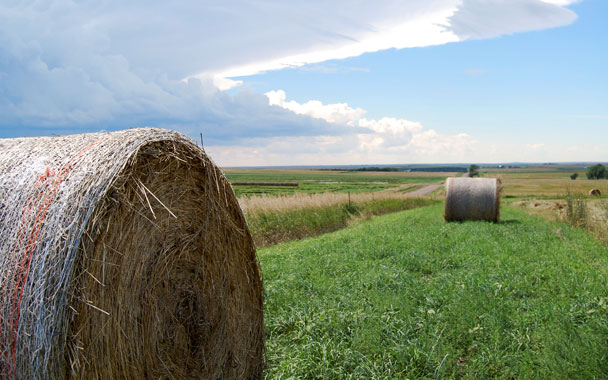All is calm in farm country. A gentle rain fell across central South Dakota this week. Charlie Johnson got a third of an inch on Monday night and joked, “We could use a freeze now. Everything is ready. It would actually make the soybean harvest a little easier if it froze for a night.” That freeze would kill the plants, making it easier for the soybean pods to fall off the stalks and go through the combine.
The calm is deceiving. The soybean harvest begins next week, but tractor and pickup radios are dialed to news reports from Washington D.C. and New York City. The Wall Street credit crisis ripples through these remote prairie farms, conjuring old, bad, really bad, memories.
“Farmers can relate to people who are trapped in debt with mortgages they can’t pay,” Johnson says. “When I started farming in the mid-eighties, I saw credit dry up.” Land valuations that most farmers use as collateral against their loans dropped a third or a half in a few years. Even if farmers could get a loan, interest rates rose to 20 percent.
“It can be very emotional. In 1986, I couldn’t get a loan to plant my crops.” That summer, four of Johnson’s neighbors took their lives. One farmer shot himself in the basement of his farmhouse. Another man jumped off his grain silo. Amid the tragedy, Johnson got lucky. CBS Evening News came to Madison, South Dakota, to report on the farm credit crisis and held a community meeting at the local country church next to Johnson’s farm. He sat at the head table with Dan Rather. Miraculously, once he appeared on network news, his credit was restored. But the price was high. When the harvest came in, every penny of crop payment had a lien on it. He couldn’t cash the checks. He couldn’t even put them in his bank account. Instead of turning them over to Farm Credit Services, he just shoved them into a drawer in his desk and let them pile up for a month—his quiet, futile act of resistance.
Credit is the backbone of American industrial farming, and the bigger the farm, the more expensive the machinery, the more intensive the chemical inputs, and the more expensive the land rents, the more dependent the farmer is on credit. Even organic farmers like Charlie Johnson find themselves trapped in the credit system. Mainstream farmers borrow for chemicals. Johnson borrows to pay for farm labor. How far we’ve come from the Jeffersonian ideal of financially independent small farmers as the backbone of our democracy. Every one of the four farmers we’ve been reporting on this summer spends the year in debt, and pays it off, as best he can, when the harvest comes in.
“I’ll be honest with you,” Dale Hargens offers. “I owe my bank about seven hundred and fifty thousand dollars.” Like most South Dakota farmers, Hargens has a production credit line at his local bank, Quoin Financial Bank, of Miller. “The bank is owned and managed by three brothers and their father. I’ve known the family my whole life. I went to school with their older sister.”
Johnson is in a similar predicament. “These days I need about $250,000 for production credit to get me through to harvest, and I’m not very big.” But surprises often overwhelm the best planning. This summer, the cost of diesel fuel went through the roof, and the cost of the migrant crew Johnson hired to cut weeds was bigger than he expected. Just a few weeks ago he had to borrow another $25,000 against his crop.
Like a tsunami, driven by the high price of oil, the landscape of farm credit has been transformed in just the last year.
Alan May is an agriculture economist at South Dakota State University. “Diesel fuel is three dollars and seventy-five cents to four dollars and twenty-five cents. That’s three times higher than three years ago. Nitrogen fertilizer used to cost twenty cents a pound. Now it costs ninety-two cents a pound. Ten years ago, you could make an assumption that the average South Dakota farm had a fifty-thousand- to seventy-five-thousand-dollar line of credit. Now, the same size farm needs five hundred thousand dollars.” The possibility that credit might not be available, or that terms will be tightened, or that land values will collapse, like in the ’80s, is unthinkable. The whole system of industrial farming, even Johnson’s organic farm, would collapse. Credit is the mother’s milk of modern farming.
While local farmers remember the ’80s, Professor May offers two potential nightmares for the future. Small rural banks don’t have huge amounts of capital. Will they be able to keep up with the huge loans that our farmers need? Will they be forced to tighten the terms of their loans? The second nightmare is even more frightening. Every one of our farmers expects to get financially healthy this winter because prices are high and yields are record breaking. The corn ethanol market is expanding, and pushing up the prices of other crops in its wake. For the first time in their lives, the promise of ethanol has created a demand-driven economy for our farmers. But ethanol companies are accumulating huge debt to launch their industry. What happens if the credit market tightens and ethanol plants postpone or cancel planned expansion? What happens if ethanol companies cannot afford to buy $6 or even $5 corn from farmers who have spent all summer borrowing money on the expectation of paying it off with big October checks?
By every measure, the upcoming soybean and corn harvests will be fabulous. But the specter of the 1980s is never very far away.


